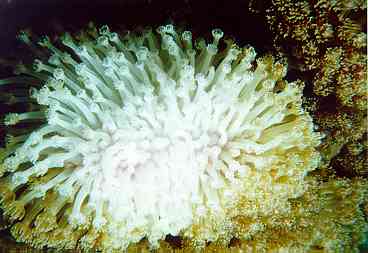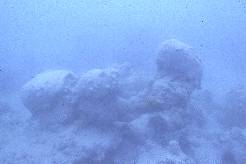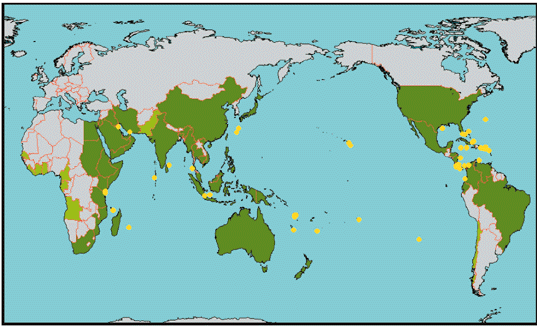Coral Reef Bleaching
http://www.marinebiology.org/coralbleaching.htmby Jason Buchheim
Director, Odyssey Expeditions
Coral reef bleaching, the whitening of diverse invertebrate taxa, results from the loss of symbiotic zooxantheallae and/or a reduction in photosynthetic pigment concentrations in zooxanthellae residing within scleractinian corals. Coral reef bleaching is caused by various anthropogenic and natural variations in the reef environment including sea temperature, solar irradiance, sedimentation, xenobiotics, subaerial exposure, inorganic nutrients, freshwater dilution, and epizootics. Coral bleaching events have been increasing in both frequency and extent worldwide in the past 20 years. Global climate change may play a role in the increase in coral bleaching events, and could cause the destruction of major reef tracts and the extinction of many coral species.
Introduction
Coral reefs are found in circumtropical shallow tropical waters along the shores of islands and continents. The reef substrate is mainly composed of calcium carbonate from living and dead scleractinian corals. Many other invertebrates, vertebrates, and plants live in close association to the scleractinian corals, with tight resource coupling and recycling, allowing coral reefs to have extremely high productivity and biodiversity, such that they are referred to as �the Tropical Rainforests of the Oceans�.
Corals live in very nutrient poor waters and have certain zones of tolerance to water temperature, salinity, UV radiation, opacity, and nutrient quantities.
Scleractinian corals build skeletons of calcium carbonate sequestered from the water. When the coral polyp dies, this skeleton remains incorporated in the reef framework.
Scleractinian corals are in the Phylum Cnidaria, and they receive their nutrient and energy resources in two ways. They use the traditional cnidarian strategy of capturing tiny planktonic organisms with their nematocyst capped tentacles, as well as having a obligate symbiotic relationship with a single cell algae known as zooxanthellae. Zooxanthellae are autorophic microalgaes belonging to various taxa in the Phylum Dinoflagellata.
Zooxanthellae live symbiotically within the coral polyp tissues and assist the coral in nutrient production through its photosynthetic activities. These activities provide the coral with fixed carbon compounds for energy, enhance calcification ,and mediate elemental nutrient flux. The host coral polyp in return provides its zooxanthellae with a protected environment to live within, and a steady supply of carbon dioxide for its photosynthetic processes. The symbiotic relationship allows the slow growing corals to compete with the faster growing multicellular algaes because the tight coupling of resources and the fact that the corals can feed by day through photosynthesis and by night through predation.
The tissues of corals themselves are actually not the beautiful colors of the coral reef, but are instead clear. The corals receive their coloration from the zooxanthellae living within their tissues.
Coral reef ecosystems world-wide have been subject to unprecedented degradation over the past few decades. Disturbances affecting coral reefs include anthropogenic and natural events. Recent accelerated coral reef decline seems to be related mostly to anthropogenic impacts (overexploitation, overfishing, increased sedimentation and nutrient overloading. Natural disturbances which cause damage to coral reefs include violent storms, flooding, high and low temperature extremes, El Nino Southern Oscillation (ENSO) events, subaerial exposures, predatory outbreaks and epizootics.
Coral reef bleaching is a common stress response of corals to many of the various disturbances mentioned above. Beginning in the 1980s, the frequency and widespread distribution of reported coral reef bleaching events increased. Widespread bleaching, involving major coral reef regions and resulting in mass coral mortality has raised concerns about linkage of the events to global phenomenons including global warming or climate change and increased UV radiation from ozone depletion. This paper examines the causes of coral reef bleaching and addresses the impact of global climate change on coral reefs.
Coral reef bleaching
Bleaching, or the paling of zooxanthellate invertebrates, occurs when (i) the densities of zooxanthellae decline and / or (ii) the concentration of photosynthetic pigments within the zooxanthellae fall (Kleppel et al. 1989). Most reef-building corals normally contain around 1-5 x 106 zooxanthellae cm-2 of live surface tissue and 2-10 pg of chlorophyll a per zooxanthella. When corals bleach they commonly lose 60-90% of their zooxanthellae and each zooxanthella may lose 50-80% of its photosynthetic pigments (Glynn 1996). The pale appearance of bleached scleractinian corals and hydrocorals is due to the cnidarian�s calcareous skeleton showing through the translucent tissues (that are nearly devoid of pigmented zooxanthellae).

Photograph of a bleaching hard coral (goniopora sp) from Pohnpei, Micronesia. Photo taken
by J Hoogesteger. Notice that the entire coral is not bleached, the polyps around the edges are still healthy.
If the stress-causing bleaching is not too severe and if it decreases in time, the affected corals usually regain their symbiotic algae within several weeks or a few months. If zooxanthellae loss is prolonged, i.e. if the stress continues and depleted zooxanthellae populations do not recover, the coral host eventually dies .
Three hypotheses have been advanced to explain the cellular mechanism of bleaching, and all are based on extreme sea temperatures as one of the causative factors. High temperature and irradiance stressors have been implicated in the disruption of enzyme systems in zooxanthellae that offer protection against oxygen toxicity. Photosynthesis pathways in zooxanthallae are impaired at temperatures above 30 degrees C, this effect could activate the disassociation of coral / algal symbiosis. Low- or high-temperature shocks results in zooxanthellae low as a result of cell adhesion dysfunction. This involves the detachment of cnidarian endodermal cells with their zooxanthellae and the eventual expulsion of both cell types.
It has been hypothesized that bleaching is an adaptive mechanism which allows the coral to be repopulated with a different type of zooxanthellae, possibly conferring greater stress resistance. Different strains of zooxanthellae exist both between and within different species of coral hosts, and the different strains of algae show varied physiological responses to both temperature and irradiance exposure. The coral / algal association may have the scope to adapt within a coral�s lifetime. Such adaptations could be either genetic or phenotypic.
Ecological causes of coral bleaching
As coral reef bleaching is a general response to stress, it can be induced by a variety of factors, alone or in combination. It is therefore difficult to unequivocally identify the causes for bleaching events. The following stressors have been implicated in coral reef bleaching events.
Temperature
Coral species live within a relatively narrow temperature margin, and anomalously low and high sea temperatures can induce coral bleaching. Bleaching events occur during sudden temperature drops accompanying intense upwelling episodes, (-3 degrees C to �5 degrees C for 5-10 days), seasonal cold-air outbreaks. Bleaching is much more frequently reported from elevated se water temperature. A small positive anomaly of 1-2 degrees C for 5-10 weeks during the summer season will usually induce bleaching.

Graph of todays sea surface temperature anomolies. Provided by satelite data from NOAA analyzed to a 50 km resolution. Color bars represent .5 degrees celcius anomolyn increments, red is possitive anomolies, blue is negative anomolies.
Solar Irradiance
Bleaching during the summer months, during seasonal temperature and irradiance maxima often occurs disproportionately in shallow-living corals and on the exposed summits of colonies. Solar radiation has been suspected to play a role in coral bleaching. Both photosyntheticaly active radiation (PAR, 400-700nm) and ultraviolet radiation (UVR, 280-400nm) have been implicated in bleaching.
Subaerial Exposure
Sudden exposure of reef flat corals to the atmosphere during events such as extreme low tides, ENSO-related sea level drops or tectonic uplift can potentially induce bleaching. The consequent exposure to high or low temperatures, increased solar radiation, desiccation, and sea water dilution by heavy rains could all play a role in zooxanthellae loss, but could also very well lead to coral death.
Sedimentation
Relatively few instances of coral bleaching have been linked solely to sediment. It is possible, but has not been demonstrated, that sediment loading could make zooxanthellate species more likely to bleach.

Fresh Water Dilution
Rapid dilution of reef waters from storm-generated precipitation and runoff has been demonstrated to cause coral reef bleaching. Generally, such bleaching events are rare and confined to relatively small, nearshore areas.
Inorganic Nutrients
Rather than causing coral reef bleaching, an increase in ambient elemental nutrient concentrations (e.g. ammonia and nitrate) actually increases zooxanthellae densities 2-3 times. Although eutrophication is not directly involved in zooxanthellae loss, it could cause secondary adverse affects such as lowering of coral resistance and greater susceptibility to diseases.
Xenobiotics
Zooxanthellae loss occurs during exposure of coral to elevated concentrations of various chemical contaminants, such as Cu, herbicides and oil. Because high concentrations of xenobiotics are required to induce zooxanthellae loss, bleaching from such sources is usually extremely localized and / or transitory .
Epizootics
Pathogen induced bleaching is different from other sorts of bleaching. Most coral diseases cause patchy or whole colony death and sloughing of soft tissues, resulting in a white skeleton (not to be confused with bleached corals). A few pathogens have been identified the cause translucent white tissues, a protozoan.
Spatial and temporal range of coral reef bleaching
Mass coral moralities in coral reef ecosystems have been reported in all major reef provinces since the 1870s. The frequency and scale of bleaching disturbances has increased dramatically since the late 70�s. This is possibly due to more observers and a greater interest in reporting in recent years. More than 60 coral reef bleaching events out of 105 mass coral moralities were reported between 1979-1990, compared with only three bleaching events among 63 mass coral moralities recorded during the preceding 103 years.
Nearly all of the world�s major coral reef regions (Caribbean/ western Atlantic, eastern Pacific, central and western Pacific, Indian Ocean, Arabian Gulf, Red Sea) experienced some degree of coral bleaching and mortality during the 1980s.

Regions where major coral reef bleaching events have taken place during the past 15 years
Yellow spots indicate major bleaching events.
Global change and reef bleaching
Of the causing stressors of coral reef bleaching, many are related to local environmental degradation and reef overexploitation. Of the stressors mentioned above, only sea water temperature and solar irradiance have possible global factors driving changes and extremes. Global warming, along with ENSO events, change sea water temperatures. Ozone depletion increases the amount of UVR reaching the Earth�s surface, and possibly causing coral bleaching events.
Increased sea temperatures and solar radiation (especially UV radiation), either separately or in combination, have received consideration as plausible large-scale stressors. In most instances, wherever coral reef bleaching was reported, it occurred during the summer season or near the end of a protracted warming period.
Coral bleaching was reported to have occurred during periods of low wind velocity, clear skies, calm seas and low turbidity, when conditions favor localized heating and high penetration of short wave length (UV) radiation. Also less oxygen is held by water at higher temperatures. Potentially stressful high sea temperatures and UV radiation flux could conceivably cause coral reef bleaching on a global scale with suspected greenhouse warming and the thinning of the ozone layer.
As reef building corals live near their upper thermal tolerance limits, small increases in sea temperature (.5 �1.5 degrees C) over several weeks or large increases (3-4 degrees C) over a few days will lead to coral dysfunction and death. Anomalously high sea temperatures have often been reported in the Caribbean-wide series of bleaching events that occurred during 1986-88, leading to hypothesis that global warming was having an effect on the coral reefs in this region.
Current hotspots for potential coral bleaching. Graph provided
by NOAA satelite data and represents anomolies from mean sea
surface temperatures recoreded for this day of the year. Color bars

represent .25 degrees celcius temperature anomolies. (White is normal, Red is +5 degrees celcius warmer.
A large-scale analysis of the relationship between coral reef bleaching and positive SST anomalies in the tropical western Atlantic, based on observations from ships and buoys, failed to disclose significant sea warming during major coral bleaching in 1987. In contrast, blended high resolution satellite SST data have shown that coral reef bleaching occurred during significant temperature increases at 5 of 7 Caribbean sites in the 1980s.
Solar ultraviolet radiation is potentially harmful to reef corals and their symbiotic. UV radiation can readily penetrate clear sea water, and reef �building corals contain UV-absorbing compounds capable of blocking potentially damaging UV radiation. These compounds are produced in response to ambient UV levels and the concentration in corals is usually an inverse function of depth, but it is not known if bleaching responses are related to variations in UV flux that exceed the protective capacity of UV-absorbing compounds. There is a possible interaction between temperature and UV, with temperature significantly reducing zooxanthelae densities and also the concentration of UV absorbing compounds in a reef zooanthid, thus potentially increasing the exposure of the symbionts to the direct effects of UV radiation.
Conclusion
If a global warming trend impacts on shallow tropical and subtropical seas, we may expect an increase in the frequency, severity and scale of coral reef bleaching. Coral mortality could exceed 95% regionally with species extirpation and extinctions. A conservative temperature increase of 1-2 degrees C would cause regions between 20-30 degrees N to experience sustained warming that falls within the lethal limits of most reef-building coral species. In conjunction with sea temperature rise would be a sea level rise, and it has been suggested that sea level rise would suppress coral growth or kill many corals through drowning or lower light levels. Some coral populations and their endosymbiotic zooxanthellae may be able to adapt to the extreme conditions predicted during global climate change. Refuges in benign habitats, such as deep, sunlit reef substrates, oceanic shoals and relatively high latitude locations, might exist, but widespread coral mortality and reef decline would be expected in shallow reef zones in most low latitude. Even if significant sea warming and elevated irradiance levels do not occur, coral reef degradation from anthropogenic pollution and overexploitation will still continue, a result of unrelenting human population growth.